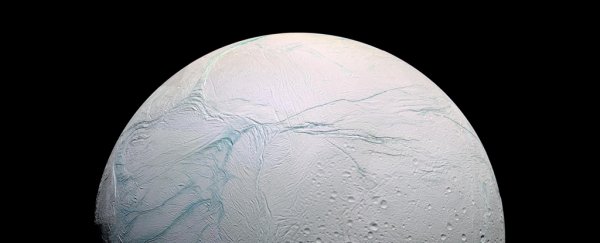Life as we know it needs three things: energy, water and chemistry.
Saturn's icy moon Enceladus has them all, as NASA spacecraft Cassini confirmed in the final years of its mission to that planet.
While Cassini explored the Saturnian neighborhood, its sensors detected gas geysers that spewed from Enceladus's southern poles. Within those plumes exists a chemical buffet of carbon dioxide, ammonia and organic compounds such as methane.
Crucially, the jets also contained molecular hydrogen - two hydrogen atoms bound as one unit. This is a coin of the microbial realm that Earth organisms can harness for energy.
Beneath Enceladus's ice shell is a liquid ocean. Astronauts looking for a cosmic vacation destination would be disappointed. The moon is oxygen-poor. There is darkness down below, too, because the moon's ice sheets reflect 90 percent of the incoming sunlight.
Despite frigid temperatures at the surface, the water is thought to reach up to 194 degrees Fahrenheit at the bottom.
As harsh as the moon's conditions are, a recent experiment suggests that Enceladus could support organisms like those that thrive on Earth.
Tiny colonies of microbes that dwell near our planet's hydrothermal vents can tolerate a simulated Enceladus habitat, according to a new report by a team of researchers in Austria and Germany.
"We tried to reproduce the putative Enceladus-like conditions in the lab," said Simon Rittmann, who studies microbes called archaea at the University of Vienna in Austria.
Archaea are microscopic, single-celled organisms. Under magnification, they resemble bacteria. Yet archaea have their own domain of life - they are as closely related to humans as they are to bacteria.
Near hydrothermal vents, beyond the reach of sunlight, their lives are fueled by chemical nutrients.
Rittmann and his colleagues constructed several growth chambers to simulate the Enceladus environment. All of their recipes included molecular hydrogen.
Astrobiologists hypothesize that a process called serpentinization creates these hydrogen molecules, a result of the chemical reaction between the moon's rocky core and its hot ocean water.
The scientists, to reflect the uncertainty of the Enceladus environment, varied the amount of molecular hydrogen available to the organisms. They also altered the pH, pressure and gas concentrations in the test habitats.
"We tried to be as broad as possible with our assumptions," Rittmann said.
There are no direct measurements for what exists beneath Enceladus's ice crust.
"No one will be able to tell if these conditions are really occurring on Enceladus," he said. "However, we did our best to be as careful as possible."
One species tested, an archaeon called Methanothermococcus okinawensi, fared the best on faux Enceladus.
Scientists discovered this organism at a hydrothermal vent system near Okinawa, Japan, 3,000 feet below sea level. M. okinawensi uses carbon dioxide as a carbon source and molecular hydrogen for energy, as a suspected Enceladus microbe might.
Not only did M. okinawensi survive most conditions, including the highest pressure tested, but also the archaeon produced methane as it grew.
An organism with a similar lifestyle might explain methane's presence on Enceladus, the scientists concluded in their study, published Wednesday in the journal Nature Communications.
There are, however, some important caveats. Cassini detected formaldehyde on Enceladus, which can disrupt the life cycle of even the hardiest archaea.
M. okinawensi could resist certain concentrations of formaldehyde but only to a point. It failed to grow at the highest formaldehyde concentrations detected by the Cassini probe.
The study also assumes that hydrothermal systems exist on Enceladus. As Rittmann emphasized, this remains an assumption.
"No evidence exists for these systems," he said. What's more, biology is not required to explain the presence of methane on Enceladus. Nonbiological processes also can create the gas.
A much-needed step, Rittmann said, will be to identify the biomarkers that serve as telltale signs of life in the solar system's deep and dark seas.
2018 © The Washington Post
This article was originally published by The Washington Post.
